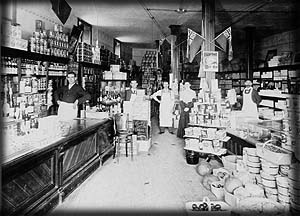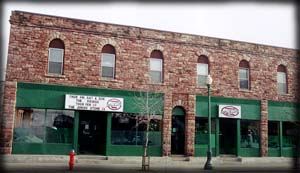|

|
DAWSON BLOCK
708-714 Queen Street East, Sault
Ste. Marie
John Dawson was
born May 10, 1847 in Ripon, England, one of 14
children of Richard and Mary Dawson. His first
wife, Jane Hawkswell, died during childbirth on
September 16, 1867. About 1869 he migrated to
Canada leaving his son, Alfred, to be raised by his
maternal grandmother. Around this time he also
married Elizabeth Todd who followed him to Canada.
They eventually settled in Sault Ste. Marie where
John purchased a small farm. Their date of arrival
in the Sault is not known. There is no mention of
them in the 1871 census. It is also unclear whether
John ever farmed the property. The 1881 census
lists him as police constable. He was also
appointed gaoler.
His respect and
influence in the community obviously grew for he
was one of the "prominent men" of the town that
spoke of the great advantages of rail connections
when the first train arrived in Sault Ste. Marie on
October 20, 1887. In 1896 he was appointed to a
deputation that went to Ottawa and Toronto to lobby
the Federal and Provincial governments for a
hospital in Sault Ste. Marie. The cornerstone of
the General Hospital was laid two years
later.
Around the turn of
the century John Dawson married for a third time,
to a widow, Mrs. Minnie Rebekah Barton Dunn. John
Dawson died on August 22, 1915. He, his second and
third wives, and all the children from the second
marriage are buried in Greenwood Cemetery.
John Dawson's
involvement in the community was extensive. He
served as alderman in 1902, 1903 and 1908, and was
an unsuccessful candidate for mayor in 1906, losing
to Dr. J. Gimby. He was initiated into the Arthur
lodge of the International Order of Oddfellows in
1890 and rose to become the Grand Marshall of the
IOOF for Ontario in 1912. He was instrumental in
founding the Children's Aid Society in Sault Ste.
Marie and served as its first president. He also
served as president of the Board of Trade,
president of the Liberal Association for the
District of Sault Ste. Marie, president of the
Humane Society, and, for 18 years, president of the
Agricultural Society. He was a member and treasurer
of the Canadian Order of Foresters and of the
Horticultural Society, and a member of the Central
Methodist Church, serving on the Quarterly Official
Board and on the Board of Trustees, of the
congregation.
|

|
Although
John Dawson was a partner in the Grocery
Business that occupied his building, he
was not an active one. His primary
interest was the John Dawson Real Estate
and Insurance business, then located an
the Corner of Queen and Elgin. John had
held an insurance license since 1892,
being the first agent for London Life in
the Sault. The grocery business was run by
two of his sons, James and George and, in
1902, he sold the block to them.
|
In 1915 James
joined his father in the insurance
business. That same year John Dawson
died, leaving the two brothers, James and George,
to run both the grocery and insurance businesses.
This must have proved to be too much for by 1918
James was involved strictly in the insurance
business while George had a new partner in the
Dawson and Gibson Grocery business, still located
in the Dawson Block. In 1919 Jams Dawson entered
local politics as a successful Aldermanic
candidate. In 1922 he was elected as the first
native born mayor of Sault Ste. Marie.
James' son, Fred,
remained active in the insurance business, now
known as Dawson and Keenan, until his death in
March 1981.

PROPERTY.
In 1876 John Dawson
purchased lots 4 and 5 of the Gouin Subdivision at
the corner of Queen and East Streets from a John M.
Hamilton who had, himself, purchased the property
only two weeks earlier from James A. Gouin, the
original subdivider.
Although Mr. Dawson
did not construct his building until 1898, an early
photograph of the Queen and East Street
intersection show that the site was previously
occupied by a pair of two story frame buildings
with stores on the ground floor, one of which was
occupied by MacQuarrie and Company. In 1914 the
Dawson Block was sold to the International Order of
Oddfellows, reflecting the close association
between this society and the Dawson family. The
Columbus Club of Sault Ste. Marie purchased the
Block in 1948. On February 13, 1953 fire swept
through the top floor of what was now called the
Knights of Columbus building. The third floor was
completely destroyed and has never been
rebuilt.
BUILDING
|
The Dawson
Block was erected in 1898. Originally
three stories high, it is constructed of
dressed, rock-faced sandstone (quarried
from the locks) to the street facades and
coursed rubble to the North and East
faces.
The
general appearance mirrors that of the
earlier buildings on the site. i.e.
Expansive store fronts at street level
with a range of six arched double-hung
windows above to the Queen Street side and
three to East street, which has no store
frontage.
|

|
The original two
storey facade was unmodelled, terminating in a
corbelled double string course surmounted by a
bell-cast mansard roof enclosing the third floor.
This was pierced with hooded, round-headed
projecting dormer windows repeating the pattern
below. The upper two floors contained apartments
and the Oddfellows' Hall. Sometime between 1906 and
1912 the third floor was rebuilt to eliminate the
Mansard roof. No documented reasons could be found
for this, but local tradition states that the
concave sides of the mansard roof constituted a
safety hazard. Apparently city council asked that
the third floor be redesigned.
The reconstructed
third floor was similar in construction to the
lower building but more elaborate in detail. The
street facades were each divided into 3 bays by
pilasters and a wider, two-tier cornice course was
supported by shallow projecting intermediate stone
brackets between the pilasters. The original round
headed windows were incorporated into the new
masonry.
The entire building
was surmounted by a projecting cornice, with paired
brackets or modillions and a dentilated frieze or
bed mould, all of pressed metal. While the scale
and proportions of the original building were not
improved by the reconstruction of the third floor,
the sensitivity of the design and the quality of
workmanship achieved were exemplary.
Following the fire
of 1953, the entire third floor was removed. The
various stages of the buildings evolution are well
documented. The building is a tangible symbol of
investment in the city by one of our pioneer
families whose faith in Sault Ste. Marie was
demonstrated by a distinguished record of service
spanning over a century.
Although the
building has been much altered over the years, the
masonry of the Queen Street facade remains,
essentially in its original condition, although
lacking the dignity and proportionality conferred
by the original attic storey.

Conclusion


|
![]()